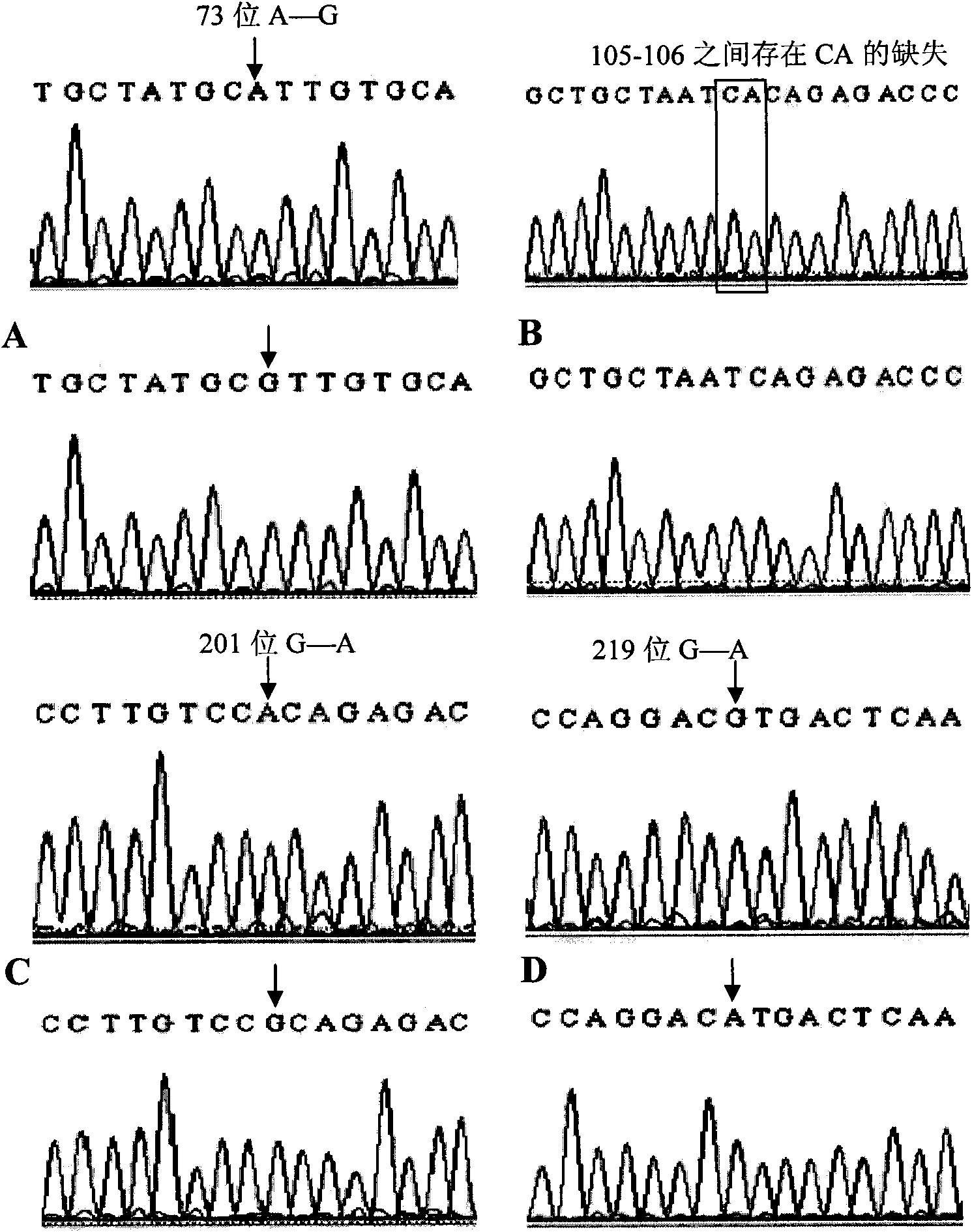Single nucleotide polymorphism (SNP) related to sheep eye muscle property and application thereof
A sheep and eye muscle technology, applied in the field of bioengineering, can solve the problems of less research on CAST gene, inability to know clearly, marker-assisted selection of sheep and breeding obstacles, etc.
- Summary
- Abstract
- Description
- Claims
- Application Information
AI Technical Summary
Problems solved by technology
Method used
Image
Examples
Embodiment 1
[0018] (1) Fully cut up about 0.3 g of muscle tissue with ophthalmic scissors, put it in a 1.5 ml centrifuge tube, and dry it for 20 minutes.
[0019] (2) Add 500 μl of tissue DNA extraction solution to the above centrifuge tube.
[0020] (3) Add RNase solution to the above centrifuge tube to a final concentration of 20 μg / ml, mix thoroughly, and digest at 37°C for 1-2 hours.
[0021] (4) Add proteinase K to the above centrifuge tube to a final concentration of 150 μg / ml, mix thoroughly, and digest at 55°C for 12-24 hours.
[0022] (5) Add an equal volume of Tris saturated phenol to the above centrifuge tube, slowly invert the centrifuge tube for 10 minutes to fully mix the two phases of the solution at 4°C, centrifuge at 12000rpm for 10 minutes, then transfer the supernatant to a clean centrifuge tube . repeat.
[0023] (6) Add an equal volume of Tris-saturated phenol:chloroform:isoamyl alcohol (25:24:1), mix well, and centrifuge at 12,000 rpm for 10 minutes at 4°C.
[00...
Embodiment 2
[0030] 1. PCR amplification
[0031] The PCR primers for PCR-SSCP are shown in the table below.
[0032] Table 1 5 pairs of specific primer sequences, annealing temperature and target fragment length
[0033]
[0034]
[0035] The PCR reaction amplification system is 25 μl, of which 10× contains Mg 2+ 2.5 μl of PCR buffer, 2 μl of dNTPs (2.5 mmol / L each), 0.4 μl (20 μmol / L) of each upstream primer and downstream primer, 0.3 μl Taq enzyme (5 U / μl), 2 μl template DNA (cDNA), ultrapure water Make up to 25μl.
[0036] The PCR reaction conditions are: pre-denaturation at 94°C for 3 minutes; enter the following cycle: denaturation at 94°C for 30 sec, the annealing temperature of each pair of primers is shown in the above table, annealing for 30 sec, extension at 72°C for 60 sec, after 35 cycles; extension at 72°C for 10 min; 4°C save. 6 μl of the PCR product was electrophoresed on a 1.5% agarose gel to detect the quality of the PCR product.
[0037] The results showed tha...
Embodiment 3
[0056] According to the method described in Example 2, PCR amplification was performed on the total DNA of 229 offspring of Dorset sheep×Hu sheep and 71 offspring of Dorset sheep×Hu sheep. Since the Nsi I enzyme can recognize the mutation at the 73 position, the Nsi I enzyme is used to carry out restriction typing after PCR restriction ( image 3 ).
[0057] The total system of enzyme digestion reaction is 20 μl, which contains 10 μl of PCR product, 2 μl of 10×Buffer (restriction enzyme specific buffer), 4-5 U of restriction enzyme, and high-pressure sterilized double distilled water to make up to 20 μl. After mixing, digest at 37°C for about 4 hours according to the instructions of the enzyme. The digested products were electrophoresed on 2.0% agarose gel at 5V / cm, observed under ultraviolet light, and photographed.
[0058] The linear model software in SASv8.02 (Statistical Analysis System) was used to analyze the correlation between different genotypes of SNPs polymorphic...
PUM
 Login to View More
Login to View More Abstract
Description
Claims
Application Information
 Login to View More
Login to View More - R&D
- Intellectual Property
- Life Sciences
- Materials
- Tech Scout
- Unparalleled Data Quality
- Higher Quality Content
- 60% Fewer Hallucinations
Browse by: Latest US Patents, China's latest patents, Technical Efficacy Thesaurus, Application Domain, Technology Topic, Popular Technical Reports.
© 2025 PatSnap. All rights reserved.Legal|Privacy policy|Modern Slavery Act Transparency Statement|Sitemap|About US| Contact US: help@patsnap.com



